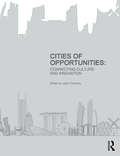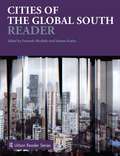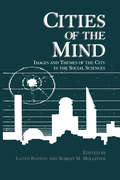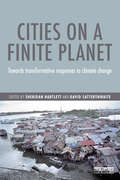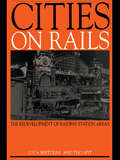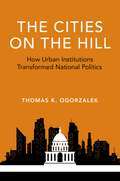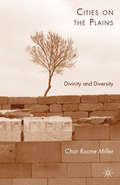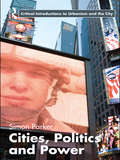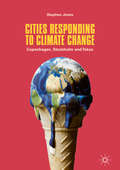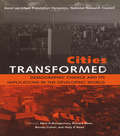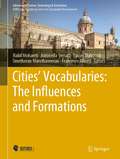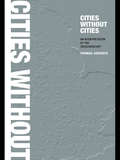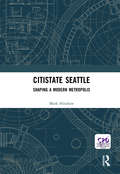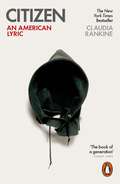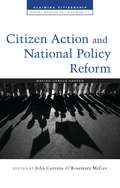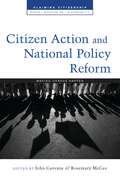- Table View
- List View
Cities of Opportunities: Connecting Culture and Innovation
by Jason PomeroyCulture refers to not only the arts but also other manifestations of human intellectual achievement regarded collectively. It similarly refers to the customs, institutions, and achievements of a social group, a people, or a nation. Innovation refers to the action or process of change, alteration, or revolution; a new method of idea creation or product that may bring about change. It is easy to assume that innovation may be juxtaposed to the preservation of culture and time-tested rituals. Yet as human settlements grew; and as streets and squares evolved through the diverse exchanges of people trading, celebrating, rallying and socially interacting, it should come as little surprise that cities and its places would become, and continue to be, centres of culture and innovation that can be inextricably linked. Culture and Innovation in cities can potentially take on different complexions if viewed through the lens of academics and practitioners drawn from different geographies, disciplines, or fields of expertise when addressing particular urban challenges. It is through this complexity of views that this book seeks to provide a broad perspective on culture and innovation in the context of global cities today; and a rich cornucopia of insights from thought leaders within their respective fields to shape the cities of tomorrow.
Cities of the Global South Reader (Routledge Urban Reader Series)
by Faranak Miraftab Neema KudvaThe Cities of the Global South Reader adopts a fresh and critical approach to the fi eld of urbanization in the developing world. The Reader incorporates both early and emerging debates about the diverse trajectories of urbanization processes in the context of the restructured global alignments in the last three decades. Emphasizing the historical legacies of colonialism, the Reader recognizes the entanglement of conditions and concepts often understood in binary relations: first/third worlds, wealth/poverty, development/underdevelopment, and inclusion/exclusion. By asking: “whose city? whose development?” the Reader rigorously highlights the fractures along lines of class, race, gender, and other socially and spatially constructed hierarchies in global South cities. The Reader’s thematic structure, where editorial introductions accompany selected texts, examines the issues and concerns that urban dwellers, planners, and policy makers face in the contemporary world. These include the urban economy, housing, basic services, infrastructure, the role of non-state civil society-based actors, planned interventions and contestations, the role of diaspora capital, the looming problem of adapting to climate change, and the increasing spectre of violence in a post 9/11 transnational world. The Cities of the Global South Reader pulls together a diverse set of readings from scholars across the world, some of which have been written specially for the volume, to provide an essential resource for a broad interdisciplinary readership at undergraduate and postgraduate levels in urban geography, urban sociology, and urban planning as well as disciplines related to international and development studies. Editorial commentaries that introduce the central issues for each theme summarize the state of the field and outline an associated bibliography. They will be of particular value for lecturers, students, and researchers, making the Cities of the Global South Reader a key text for those interested in understanding contemporary urbanization processes.
Cities of the Global South Reader (Routledge Urban Reader Series)
by Faranak Miraftab Neema KudvaThe Cities of the Global South Reader adopts a fresh and critical approach to the fi eld of urbanization in the developing world. The Reader incorporates both early and emerging debates about the diverse trajectories of urbanization processes in the context of the restructured global alignments in the last three decades. Emphasizing the historical legacies of colonialism, the Reader recognizes the entanglement of conditions and concepts often understood in binary relations: first/third worlds, wealth/poverty, development/underdevelopment, and inclusion/exclusion. By asking: “whose city? whose development?” the Reader rigorously highlights the fractures along lines of class, race, gender, and other socially and spatially constructed hierarchies in global South cities. The Reader’s thematic structure, where editorial introductions accompany selected texts, examines the issues and concerns that urban dwellers, planners, and policy makers face in the contemporary world. These include the urban economy, housing, basic services, infrastructure, the role of non-state civil society-based actors, planned interventions and contestations, the role of diaspora capital, the looming problem of adapting to climate change, and the increasing spectre of violence in a post 9/11 transnational world. The Cities of the Global South Reader pulls together a diverse set of readings from scholars across the world, some of which have been written specially for the volume, to provide an essential resource for a broad interdisciplinary readership at undergraduate and postgraduate levels in urban geography, urban sociology, and urban planning as well as disciplines related to international and development studies. Editorial commentaries that introduce the central issues for each theme summarize the state of the field and outline an associated bibliography. They will be of particular value for lecturers, students, and researchers, making the Cities of the Global South Reader a key text for those interested in understanding contemporary urbanization processes.
Cities of the Mind: Images and Themes of the City in the Social Sciences (Environment, Development and Public Policy: Cities and Development)
by Lloyd Rodwin Robert M. HollisterCurious about the images of the city that have been evolving in the different social sciences, we did what academics often do in such a situa 1 tion: we set up a seminar on "Images of the City in the Social Sciences." From the start, we counted on the help of specialists in other fields to pursue their interests. Of the persons who agreed to participate, all but two came from the United States, and their analyses, in the main, reflect the experience of Western countries and the United States. In our formal instructions to our collaborators, we took fi>r granted that a variety of images of the city could be found or inferred in their fields of expertise. We asked them to identify these images and their functions, to explain how and why they have changed over time, and to relate these images to the distinct intellectual traditions and techniques-analytical or otherwise-in their respective fields. The definition of image was left to the judgment of the participants.
Cities on a Finite Planet: Towards transformative responses to climate change
by Sheridan Bartlett David SatterthwaiteCities on a Finite Planet: Transformative responses to climate change shows how cities can combine high quality living conditions, resilience to climate change, disaster risk reduction and contributions to mitigation/low carbon development. It also covers the current and potential contribution of cities to avoiding dangerous climate change and is the first book with an in-depth coverage of how cities and their governments, citizens and civil society organizations can combine these different agendas, based on careful city-level analyses. The foundation for the book is detailed city case studies on Bangalore, Bangkok, Dar es Salaam, Durban, London, Manizales, Mexico City, New York and Rosario. Each of these was led by authors who contributed to the IPCC’s Fifth Assessment and are thus acknowledged as among the world’s top specialists in this field. This book highlights where there is innovation and progress in cities and how this was achieved. Also where there is little progress and no action and where there is no capacity to act. It also assesses the extent to which cities can address the Sustainable Development Goals within commitments to also dramatically reduce greenhouse gas emissions. In this, it highlights how much progress on these different agendas depends on local governments and their capacities to work with their low-income populations.
Cities on a Finite Planet: Towards transformative responses to climate change
by Sheridan Bartlett David SatterthwaiteCities on a Finite Planet: Transformative responses to climate change shows how cities can combine high quality living conditions, resilience to climate change, disaster risk reduction and contributions to mitigation/low carbon development. It also covers the current and potential contribution of cities to avoiding dangerous climate change and is the first book with an in-depth coverage of how cities and their governments, citizens and civil society organizations can combine these different agendas, based on careful city-level analyses. The foundation for the book is detailed city case studies on Bangalore, Bangkok, Dar es Salaam, Durban, London, Manizales, Mexico City, New York and Rosario. Each of these was led by authors who contributed to the IPCC’s Fifth Assessment and are thus acknowledged as among the world’s top specialists in this field. This book highlights where there is innovation and progress in cities and how this was achieved. Also where there is little progress and no action and where there is no capacity to act. It also assesses the extent to which cities can address the Sustainable Development Goals within commitments to also dramatically reduce greenhouse gas emissions. In this, it highlights how much progress on these different agendas depends on local governments and their capacities to work with their low-income populations.
Cities on Rails: The Redevelopment of Railway Stations and their Surroundings
by Luca Bertolini Tejo SpitThe development of railway stations and their surroundings is an emerging feature in current urban projects. Based on a series of the most inspiring contemporary European examples of station redevelopment, this book will help planners and urban designers understand the specific and complex nature of station locations. Based on their extensive research, the authors, pioneers of studies in the field in the last few years, harness and expand the body of knowledge and present guiding principles and conditions for successful implementation of such planning projects.
Cities on Rails: The Redevelopment of Railway Stations and their Surroundings
by Luca Bertolini Tejo SpitThe development of railway stations and their surroundings is an emerging feature in current urban projects. Based on a series of the most inspiring contemporary European examples of station redevelopment, this book will help planners and urban designers understand the specific and complex nature of station locations. Based on their extensive research, the authors, pioneers of studies in the field in the last few years, harness and expand the body of knowledge and present guiding principles and conditions for successful implementation of such planning projects.
The Cities on the Hill: How Urban Institutions Transformed National Politics (Studies in Postwar American Political Development)
by Thomas K. OgorzalekOver the second half of the 20th century, American politics was reorganized around race as the tenuous New Deal coalition frayed and eventually collapsed. What drove this change? In The Cities on the Hill, Thomas Ogorzalek argues that the answer lies not in the sectional divide between North and South, but in the differences between how cities and rural areas govern themselves and pursue their interests on the national stage. Using a wide range of evidence from Congress and an original dataset measuring the urbanicity of districts over time, he shows how the trajectory of partisan politics in America today was set in the very beginning of the New Deal. Both rural and urban America were riven with local racial conflict, but beginning in the 1930s, city leaders became increasingly unified in national politics and supportive of civil rights, changes that sowed the seeds of modern liberalism. As Ogorzalek powerfully demonstrates, the red and blue shades of contemporary political geography derive more from rural and urban perspectives than clean state or regional lines-but local institutions can help bridges the divides that keep Americans apart.
CITIES ON THE HILL PAPD C: How Urban Institutions Transformed National Politics (Studies in Postwar American Political Development)
by Thomas K. OgorzalekOver the second half of the 20th century, American politics was reorganized around race as the tenuous New Deal coalition frayed and eventually collapsed. What drove this change? In The Cities on the Hill, Thomas Ogorzalek argues that the answer lies not in the sectional divide between North and South, but in the differences between how cities and rural areas govern themselves and pursue their interests on the national stage. Using a wide range of evidence from Congress and an original dataset measuring the urbanicity of districts over time, he shows how the trajectory of partisan politics in America today was set in the very beginning of the New Deal. Both rural and urban America were riven with local racial conflict, but beginning in the 1930s, city leaders became increasingly unified in national politics and supportive of civil rights, changes that sowed the seeds of modern liberalism. As Ogorzalek powerfully demonstrates, the red and blue shades of contemporary political geography derive more from rural and urban perspectives than clean state or regional lines-but local institutions can help bridges the divides that keep Americans apart.
Cities on the Plains: Divinity and Diversity
by C. MillerTheological concepts continue to maintain political concepts well after those theological concepts are no longer supported by belief. Cities on the Plains examines some of these concepts in the light of five different times and places. It is both a response to theological concerns in contemporary political theory and broadly accessible examination of familiar political issues touched by the divine - such as gay marriage, 911, or the French tradition of laicité. Concerns of difference and the divine are pursued through broadly familiar texts (the Bible, and Gore Vidal), significant texts of political theory (Plato and Augustine), and less common texts (Averroes). Gods, or the intellectual territory they used to occupy, are treated as important features of the political; contesting with these gods can help us visit, defend, and desire, (to paraphrase Deleuze and Guatarri) new cities and new peoples.
Cities, Politics & Power
by Simon ParkerTraditionally, the study of ‘power in the city’ was confined to the institutions of urban government and the actors involved in contesting and making political decisions in and for metropolitan societies. Increasingly, however, attention has turned to the function of the city not only as a centre of urban governance but as a major economic, social, cultural and strategic force in its own right. Cities, Politics and Power combines this traditional concern with how the cities in which we live are organized and run with a broader focus on cities and urban regions as multiple sites and agents of power. This book is divided into five sections, with a short introduction outlining the argument and organisation of the text. Part two charts the development of the urban polity and considers the ways in which coercion and force continue to be used to segregate, oppress and annihilate urban populations. Part three critically examines the key collective actors and processes that compete for and organise political power within cities, and how urban governance operates and interacts with lesser and greater scales of government and networks of power. Part four then explores the ways in which ‘the political’ is constituted by urban inhabitants, and how social identity, information and communication networks, and the natural and built environment all comprise intersecting fields of urban power. The conclusion calls for a broader theoretical and thematic approach to the study of urban politics. This book makes extensive use of comparative and historical case studies, providing broad coverage of politics and urban movements in both the Global North and the Global South, with a particular focus on the UK, USA, Canada, Latin America and China. It is written in an accessible and lucid style and provides suggestions for further reading at the end each chapter.
Cities, Politics & Power
by Simon ParkerTraditionally, the study of ‘power in the city’ was confined to the institutions of urban government and the actors involved in contesting and making political decisions in and for metropolitan societies. Increasingly, however, attention has turned to the function of the city not only as a centre of urban governance but as a major economic, social, cultural and strategic force in its own right. Cities, Politics and Power combines this traditional concern with how the cities in which we live are organized and run with a broader focus on cities and urban regions as multiple sites and agents of power. This book is divided into five sections, with a short introduction outlining the argument and organisation of the text. Part two charts the development of the urban polity and considers the ways in which coercion and force continue to be used to segregate, oppress and annihilate urban populations. Part three critically examines the key collective actors and processes that compete for and organise political power within cities, and how urban governance operates and interacts with lesser and greater scales of government and networks of power. Part four then explores the ways in which ‘the political’ is constituted by urban inhabitants, and how social identity, information and communication networks, and the natural and built environment all comprise intersecting fields of urban power. The conclusion calls for a broader theoretical and thematic approach to the study of urban politics. This book makes extensive use of comparative and historical case studies, providing broad coverage of politics and urban movements in both the Global North and the Global South, with a particular focus on the UK, USA, Canada, Latin America and China. It is written in an accessible and lucid style and provides suggestions for further reading at the end each chapter.
Cities Responding to Climate Change: Copenhagen, Stockholm and Tokyo
by Stephen JonesThis book explores the climate policy approaches established by various city governments. It details the strategies, plans and initiatives that have so far been designed to both mitigate and adapt to the impacts of global warming. In doing so, it considers the implications of the actions taken by leading cities and its effects on underlying theoretical assumptions relating to policy development and management processes in achieving climate policy outcomes. Cities Responding to Climate Change establishes an analytical framework that critically examines the application of performance management by city governments in their policy responses to climate change. It draws its focus on the city governments of Copenhagen, Stockholm and Tokyo to bring together and discuss the concepts, strategies and practices that have since been introduced to respond to the climate challenges faced. This book highlights the lessons to be learned by other city governments around the world contemplating serious action with climate policies to lessen the impacts of global warming. It will be of particular interest to practitioners and researchers seeking evidence of how governments deliver on their commitments and improve their effectiveness in implementing climate polices.
Cities Responding to Climate Change: Copenhagen, Stockholm and Tokyo
by Stephen JonesThis book explores the climate policy approaches established by various city governments. It details the strategies, plans and initiatives that have so far been designed to both mitigate and adapt to the impacts of global warming. In doing so, it considers the implications of the actions taken by leading cities and its effects on underlying theoretical assumptions relating to policy development and management processes in achieving climate policy outcomes. Cities Responding to Climate Change establishes an analytical framework that critically examines the application of performance management by city governments in their policy responses to climate change. It draws its focus on the city governments of Copenhagen, Stockholm and Tokyo to bring together and discuss the concepts, strategies and practices that have since been introduced to respond to the climate challenges faced. This book highlights the lessons to be learned by other city governments around the world contemplating serious action with climate policies to lessen the impacts of global warming. It will be of particular interest to practitioners and researchers seeking evidence of how governments deliver on their commitments and improve their effectiveness in implementing climate polices.
Cities Transformed: Demographic Change and Its Implications in the Developing World
by Mark R. Montgomery Richard Stren Barney Cohen Holly E. ReedOver the next 20 years, most low-income countries will, for the first time, become more urban than rural. Understanding demographic trends in the cities of the developing world is critical to those countries - their societies, economies, and environments. The benefits from urbanization cannot be overlooked, but the speed and sheer scale of this transformation presents many challenges. In this uniquely thorough and authoritative volume, 16 of the world's leading scholars on urban population and development have worked together to produce the most comprehensive and detailed analysis of the changes taking place in cities and their implications and impacts. They focus on population dynamics, social and economic differentiation, fertility and reproductive health, mortality and morbidity, labor force, and urban governance. As many national governments decentralize and devolve their functions, the nature of urban management and governance is undergoing fundamental transformation, with programs in poverty alleviation, health, education, and public services increasingly being deposited in the hands of untested municipal and regional governments. Cities Transformed identifies a new class of policy maker emerging to take up the growing responsibilities. Drawing from a wide variety of data sources, many of them previously inaccessible, this essential text will become the benchmark for all involved in city-level research, policy, planning, and investment decisions. The National Research Council is a private, non-profit institution based in Washington, DC, providing services to the US government, the public, and the scientific and engineering communities. The editors are members of the Council's Panel on Urban Population Dynamics.
Cities Transformed: Demographic Change and Its Implications in the Developing World
by Mark R. Montgomery Richard Stren Barney Cohen Holly E. ReedOver the next 20 years, most low-income countries will, for the first time, become more urban than rural. Understanding demographic trends in the cities of the developing world is critical to those countries - their societies, economies, and environments. The benefits from urbanization cannot be overlooked, but the speed and sheer scale of this transformation presents many challenges. In this uniquely thorough and authoritative volume, 16 of the world's leading scholars on urban population and development have worked together to produce the most comprehensive and detailed analysis of the changes taking place in cities and their implications and impacts. They focus on population dynamics, social and economic differentiation, fertility and reproductive health, mortality and morbidity, labor force, and urban governance. As many national governments decentralize and devolve their functions, the nature of urban management and governance is undergoing fundamental transformation, with programs in poverty alleviation, health, education, and public services increasingly being deposited in the hands of untested municipal and regional governments. Cities Transformed identifies a new class of policy maker emerging to take up the growing responsibilities. Drawing from a wide variety of data sources, many of them previously inaccessible, this essential text will become the benchmark for all involved in city-level research, policy, planning, and investment decisions. The National Research Council is a private, non-profit institution based in Washington, DC, providing services to the US government, the public, and the scientific and engineering communities. The editors are members of the Council's Panel on Urban Population Dynamics.
Cities’ Vocabularies: The Influences and Formations (Advances in Science, Technology & Innovation)
by Nabil Mohareb Antonella Versaci Yasser Mahgoub Sreetheran Maruthaveeran Francesco AlbertiThis book discusses several topics regarding different vocabularies, such as sacred architecture, heritage buildings, open spaces, landmarks, and street escapes, all of which have a direct influence on the city form. The city form is also affected by the indirect impact of the citizens themselves, for example their culture, which in turn depends on the arts, as can be seen and embodied in morals, paintings, media, digital art, and sculpture. The book also examines the fundamental elements that are responsible for the identity of the city. Presenting case studies that demonstrate the how implementing the concept of the responsibility of architecture and arts affects the development of our cities, the book offers a new approach that is based on the available features of a city and explores how planners and decision-makers can use these features to address the myriad problems that our cities are facing.
Cities Without Cities: An Interpretation of the Zwischenstadt
by Thomas SievertsThis book investigates the characteristics of today's built environment: no longer simply a city but increasingly large conurbations made up of a number of development clusters, linked by transport routes. The diffusion of the once compact city into a city web, the 'meta city' is mirrored by changes in society from communities with strong social cohesion and interest in their towns and cities to individuals pursing their own goals, with global social links and little interest in their city.
Cities Without Cities: An Interpretation of the Zwischenstadt
by Thomas SievertsThis book investigates the characteristics of today's built environment: no longer simply a city but increasingly large conurbations made up of a number of development clusters, linked by transport routes. The diffusion of the once compact city into a city web, the 'meta city' is mirrored by changes in society from communities with strong social cohesion and interest in their towns and cities to individuals pursing their own goals, with global social links and little interest in their city.
Citistate Seattle: Shaping A Modern Metropolis
by Mark HinshawWith style and humor, the author writes of special places in everyday Seattle. The author takes us to popular, high-profile landmarks like Pike Place Market as well as tucked-away gems — cozy cottages, trendy pubs, gracious apartment buildings, and vibrant urban villages — that flavor and enliven the city. The author shares his eye for unique, humanizing details of design, architecture, and function, bringing this colorful metropolis to life so vividly you'll practically smell the coffee they brew and sell on (almost) every street corner. Along the way, the author explains the public and private decisions that helped Seattle avoid the urban desolation that plagues other American cities. The author introduces many of Seattle's movers and shakers — mayors, developers, artists, and urban pioneers — who took it upon themselves to guide metropolitan Seattle along a different path.
Citistate Seattle: Shaping A Modern Metropolis
by Mark HinshawWith style and humor, the author writes of special places in everyday Seattle. The author takes us to popular, high-profile landmarks like Pike Place Market as well as tucked-away gems — cozy cottages, trendy pubs, gracious apartment buildings, and vibrant urban villages — that flavor and enliven the city. The author shares his eye for unique, humanizing details of design, architecture, and function, bringing this colorful metropolis to life so vividly you'll practically smell the coffee they brew and sell on (almost) every street corner. Along the way, the author explains the public and private decisions that helped Seattle avoid the urban desolation that plagues other American cities. The author introduces many of Seattle's movers and shakers — mayors, developers, artists, and urban pioneers — who took it upon themselves to guide metropolitan Seattle along a different path.
Citizen: An American Lyric
by Claudia RankineWINNER OF THE LOS ANGELES TIMES BOOK PRIZE FOR POETRYWINNER OF THE NATIONAL BOOK CRITICS CIRCLE AWARD FOR POETRYIn this moving, critical and fiercely intelligent collection of prose poems, Claudia Rankine examines the experience of race and racism in Western society through sharp vignettes of everyday discrimination and prejudice, and longer meditations on the violence - whether linguistic or physical - which has impacted the lives of Serena Williams, Zinedine Zidane, Mark Duggan and others.Awarded the National Book Critics Circle Award for Poetry in America after becoming the first book in the prize's history to be a finalist in both the poetry and criticism categories, Citizen weaves essays, images and poetry together to form a powerful testament to the individual and collective effects of racism in an ostensibly "post-race" society.
Citizen Action and National Policy Reform: Making Change Happen (Claiming Citizenship)
by Rabéa Naciri Amita Baviskar Michael D. Layton Ana Maria Rodriguez Claudio A. Fuentes Beatriz Campillo Carrete Jennifer C. Franco Steven Friedman Ireri Ablanedo Terrazas Saturnino M. Borras Pinar IlkkaracanHow does citizen activism win changes in national policy? Which factors help to make myriad efforts by diverse actors add up to reform? What is needed to overcome setbacks, and to consolidate the smaller victories?These questions need answers. Aid agencies have invested heavily in supporting civil society organizations as change agents in fledgling and established democracies alike. Evidence gathered by donors, NGOs and academics demonstrates how advocacy and campaigning can reconfigure power relations and transform governance structures at the local and global levels. In the rush to go global or stay local, however, the national policy sphere was recently neglected. Today, there is growing recognition of the key role of champions of change inside national governments, and the potential of their engagement with citizen activists outside. These advances demand a better understanding of how national and local actors can combine approaches to simultaneously work the levers of change, and how their successes relate to actors and institutions at the international level.This book brings together eight studies of successful cases of citizen activism for national policy changes in South Africa, Morocco, Brazil, Chile, Mexico, Turkey, India and the Philippines. They detail the dynamics and strategies that have led to the introduction, change or effective implementation of policies responding to a range of rights deficits. Drawing on influential social science theory about how political and social change occurs, the book brings new empirical insights to bear on it, both challenging and enriching current understandings.
Citizen Action and National Policy Reform: Making Change Happen (Claiming Citizenship)
by Rabéa Naciri Amita Baviskar Michael D. Layton Ana Maria Rodriguez Claudio A. Fuentes Beatriz Campillo Carrete Jennifer C. Franco Steven Friedman Ireri Ablanedo Terrazas Saturnino M. Borras Pinar IlkkaracanHow does citizen activism win changes in national policy? Which factors help to make myriad efforts by diverse actors add up to reform? What is needed to overcome setbacks, and to consolidate the smaller victories?These questions need answers. Aid agencies have invested heavily in supporting civil society organizations as change agents in fledgling and established democracies alike. Evidence gathered by donors, NGOs and academics demonstrates how advocacy and campaigning can reconfigure power relations and transform governance structures at the local and global levels. In the rush to go global or stay local, however, the national policy sphere was recently neglected. Today, there is growing recognition of the key role of champions of change inside national governments, and the potential of their engagement with citizen activists outside. These advances demand a better understanding of how national and local actors can combine approaches to simultaneously work the levers of change, and how their successes relate to actors and institutions at the international level.This book brings together eight studies of successful cases of citizen activism for national policy changes in South Africa, Morocco, Brazil, Chile, Mexico, Turkey, India and the Philippines. They detail the dynamics and strategies that have led to the introduction, change or effective implementation of policies responding to a range of rights deficits. Drawing on influential social science theory about how political and social change occurs, the book brings new empirical insights to bear on it, both challenging and enriching current understandings.
